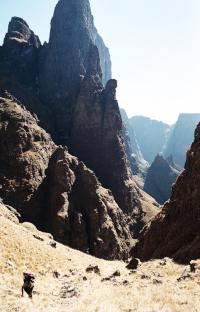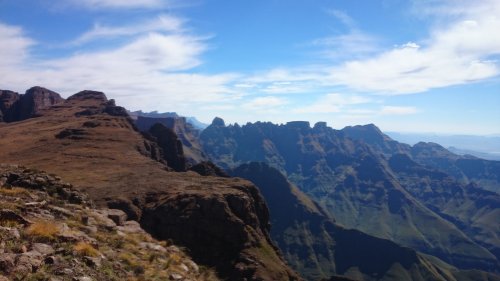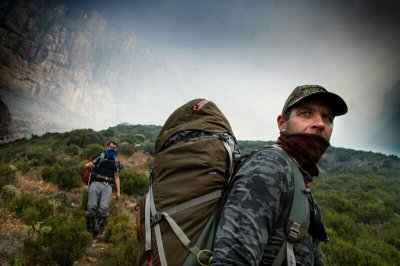Tseketseke Pass
make a difference. today.
Please Log in or Create an account to join the conversation.
This is what I did for the belay shown above - I would like feedback from the climbers on the forum as to the correctness of my technique:
1) I tested the only suitable rock by giving it a good kick, push and seeing if I could get it to budge in any way. It was solid
2) I used a triple fishermans knot to make a loop in the end of my rope.
3) The rock didn't have any form of catch to get the rope around, there was a small notch in the rock which held the rope in place, so this was used.
4) Before anyone went, I pulled down with all my weight on the end of the rope to see if the knot and rope placement was solid. It was.
5) I tied the other end of the rope into a rope harness. I would usually use a sling, but didn't have one on this occasion.
6) Everyone was instructed not to fall as the system would only stop them from hitting the ground, but a rope harness will give you a monster wedgy!
7) After the rope harness was put onto the first person, a locking biner and belay device was attached to an overhand knot tied just past the anchor (if put through the loop, a fall would just pull the loop around the rock loose). Standard belay procedure was followed (with the normal command words).
No one fell, so the system was never tested, but I rate this precaution was necessary. A watercourse can be slippery...
I rate that a few sessions at a climbing gym is a good idea for all hikers. Even if just to learn some basic knots, how to belay and also how to secure an anchor (although that would be best learned at a crag).
A harness can be improvised on the end of a rope, although a sling is slightly better (I have abseiled off a sling improvised harness once, it was painful, but did the trick). A munter hitch can be used in place of a belay device. But, to the best of my knowledge, you can't get away without a caribiner. And the biner must always be a locker as ropes do funny things when you load them!
Important notes on gear:
- Don't use hardware biners, only use climbing biners which you buy from a climbing shop.
- Only use locking biners.
- The rope you use must be suitable for a belay device. "Outdoor rope" as sold by Mr Price Sport/Dischem etc doesn't bite on a belay device and isn't rated to stop a fall. Buy this from a shop that sells climbing gear and make sure the salesperson does climbing themself before you take their advice. I often hear "I'm sure it's fine" or "of course it will work for that" from people who have no clue what they are talking about. I personally will only buy the rope I use for things like this from either Bush 'n Bundu (with Cesar as the salesperson) or Mountain Mail Order (which is a climbing gym) and with them confirming that it is suitable for improvised abseils or belay.
- I use 8mm access chord for this. This is rated to take a large amount of weight, but is not a climbing rope, so it isn't designed to take falls.
- Never buy rope second hand. If it takes a major impact, inspect it before using it again. If it takes a few big impacts, replace it.
- Replace it every 5 years
- You need 20m of rope for a relatively short belay. 20m sounds like a lot, but the harness uses 2m, the anchor could easily use 5m if it is a big solid rock and could easily be 5m from the obstacle. If it is 10m or higher, you really shouldn't be using a system like this, so more than 20m is probably overkill.
As mentioned above - I would appreciate feedback on the above from the guys who are more experienced with these kind of system.
Please Log in or Create an account to join the conversation.
We had walked in up the Tseketseke valley the previous day, past the Blue Pools. There is a trail from the turnoff up the Tseketseke valley from the main path to Mlambonja Pass, up the Tseketseke valley to the vicinity of the Blue Pools. Further upstream the trail vanishes, but it is easy enough to boulder hop on the boulders of the stream bed. This is necessary all the way upstream to the Contour Path crossing of the Tseketseke River, and further upstream to the Tseketseke Hut.
Upstream of the Tseketseke Hut there is a trail developing in the wide boulder bed of the river, but if you miss it just keep following the boulder bed upstream. The developing trail isn’t strong and comes and goes a lot. Heading upstream, a small remaining cluster of ring barked dead and dying pine trees is visible on the left (true right) of the stream, and it is necessary to stay in the boulder bed to just past this cluster of pine trees before the pass trail begins. The pine tree cluster is approximately 1 km upsteam of the Tseketseke Hut, and the beginning of the trail about 100 m upsteam of the pine tree cluster.
Since our group ascended and descended the trail, I have combined photos below from both directions to show the detail of the trail, although I will describe the route heading upstream up the pass.
We took a break where the trail starts, and filled up with water as the trail leaves the stream here and the stream was dry when we crossed it again higher upstream (although in summer there should be water at the upstream crossing). The photo below shows the gully exit from the stream, at the start of the trail on the right (true left) of the stream, with the exit from the stream bed at the right of the photo. The gps co ordinates of the stream exit to the trail are (WGS84) S 28° 59.540 E 29° 10.059 at 2255 m. The stream exit is marked with cairns.
Just upstream of the trail exit, looking back downstream to the pine tree cluster, which is a useful marker to judge the position of the trail exit. We have ring barked all of the trees now, so hopefully they will soon all be dead.
The group heading up the trail on the true left.
Higher up the trail with Column in the background.
Further upstream the trail comes back into the stream bed as the stream crossing is approached.
Please login or register to view the images attached to this post.
Please Log in or Create an account to join the conversation.
- tonymarshall
-

- Offline
- VE Advisory
-

- Posts: 740
- Thank you received: 2097
The photo below is taken from the same point as the previous photo, back downstream to the stream crossing. When heading upstream the crossing is very obvious, but when heading downstream it is not so easy to find, and there is a bit of a false trail staying on the true right, so look out carefully for the correct trail.
The trail keeps to the true right up to the top of the pass, with several zig zag sections.
The top of Tseketseke Pass with the distinct trail.
A gps map of the route, showing the salient points, with our track of the pass descent.
Please login or register to view the images attached to this post.
Please Log in or Create an account to join the conversation.
- tonymarshall
-

- Offline
- VE Advisory
-

- Posts: 740
- Thank you received: 2097
About 500m from the hut the markers run out but keep going down till you reach a timber cross marker and the stone markers re appear. From the hut to the path connecting to the contour path is about 500m just past the collapsed river bank on the south side of the river bed. Look for the stone markers leading to a cleared camp area in the bush. Worth noting is more than one path leading off through the bush. These paths are very over grown and it is important that you dont select the wrong path and get lost walking in circles. Spend a few minutes checking out which track is the right one before dragging the while group with you.
Lessons learned.
Take enough drinking water from the top to last for at least 3 + hours.
Don’t under estimate the time it will take to do this pass (one day from the top to the little berg is a safe estimate )
Concerntrate on your foot positions. Nothing is stable and minor falls could result in a twisted ancle or worse.
Stay together as a group within visual sight.
Our 10m rope came in handy when we needed to drop our packs over a steep section rather than climb down with packs on your back.
We have done Shipsprow pass more than 21 years ago, but having done this pass (even though way shorter and less height drop) rates well up there as one of the toughest and demanding decents I have done with a full load. Don’t attempt this if you are not physically and mentally up to the challenge. The views of the rock spires and cliffs around the pass are spectacular but know the price you need to pay in blood sweat and tears when attempting this pass
Please Log in or Create an account to join the conversation.
- brettross32
-

- Offline
- New Member
-

- Posts: 1
- Thank you received: 1
Please Log in or Create an account to join the conversation.
- TheRealDave
-

- Offline
- Elite Member
-

- Posts: 192
- Thank you received: 243
There is definitely a few dodgy places on this route, on one particular section you walk very close to the edge and should the ground give way (it is unstable close to the edges, especially when water logged) then you are in for a nasty slide down the walls into the riverbed about 20m or so below.
I found Tseke to be a really nice pass, lots of varied terrain to keep things interesting with a grassy section the last 300m or so to the top. Unlike something like Ifidi which has miles of rock hopping right to the top, and 3 climbing sections to boot in the last 100m to the top of the pass.
Other than the timeframe allocated for this pass the lessons learnt are all very valid points. Fully agreed on the lack of clear paths here. Last hike here a few months ago was in the mist and if you don't know where to go or don't have a gps track then climbing out of the riverbed it is difficult to see the path. Is it just my imagination or are the paths in the (especially lower) berg becoming more overgrown? Did a hike in Moncs Cowl 2 weeks ago and on the North side of Newmans' ridhe there were long stretches where the contour path is completely overgrown. Would be interesting in the mist.........
Please Log in or Create an account to join the conversation.
tonymarshall wrote: As the fun part of the VE Berg Trip 2, Intrepid, diverian and tonymarshall did a day trip up and down Tseketseke Pass, combined with felling and ringbarking pine trees in the upper Tsekeseke valley.
The previous day we departed from the hotel hikers parking area, past the stables and into the Tseketseke valley past the Blue Pools. Even low down the valley, there was evidence of flash flood damage from the March 2011 flash flood in the Tseketseke catchment.
We were to stay in the river bed the whole way to the Tseketseke Hut, our overnight spot (except for several detours out of the river to cut pine trees.) Near a large copse of pine trees which we tackled, spectacular views of the Camel, Organ Pipes and Castle Buttress were afforded from the bank above the river. Note the lone pine tree to the right in the photo.
As we approached the Tseketseke Hut from downstream, it was apparent how close the hut (in the centre of the photo below) had come to being destroyed in the flash flood, with the erosion adjacent to and downstream of the hut leaving it on an island.
Below is a view of the upper Tseketseke and Tseketseke Pass from the contour path, with Cleft Peak, Column and Pyramid dominating the skyline.
The next morning we headed upstream, and not far from the hut caught the first sight of the top of the valley and pass. It was to be a day of more boulder hopping.
We stayed in the boulder bed until about 2550 m where we found a trail on the left (southern) bank which followed the grass slope to the top of the pass at 3000 m. A view down Tseketseke Pass.
First post here, and thought I'd revive an old thread. Really found this pic interesting because I have great memories of coming down Tseketseke in late 2008 so I decided to do some digging and found this gem of a pic taken form nearly the same spot. The two pic's show resulting effect of the flood on the pass.
Please login or register to view the image attached to this post.
Please Log in or Create an account to join the conversation.
Please Log in or Create an account to join the conversation.
Thanks for looking for the old photo and sharing it!
Please Log in or Create an account to join the conversation.
- GerritHuman
-

- Offline
- Elite Member
-

- Posts: 152
- Thank you received: 58




